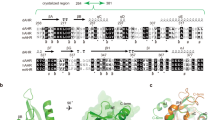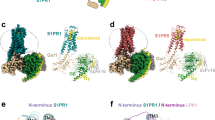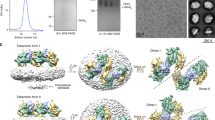Abstract
The human nuclear receptor liver receptor homolog 1 (hLRH-1) plays an important role in the development of breast carcinomas. This orphan receptor is efficiently downregulated by the unusual co-repressor SHP and has been thought to be ligand-independent. We present the crystal structure at a resolution of 1.9 Å of the ligand-binding domain of hLRH-1 in complex with the NR box 1 motif of human SHP, which we find contacts the AF-2 region of hLRH-1 using selective structural motifs. Electron density indicates phospholipid bound within the ligand-binding pocket, which we confirm using mass spectrometry of solvent-extracted samples. We further show that pocket mutations reduce phospholipid binding and receptor activity in vivo. Our results indicate that hLRH-1's control of gene expression is mediated by phospholipid binding, and establish hLRH-1 as a novel target for compounds designed to slow breast cancer development.
This is a preview of subscription content, access via your institution
Access options
Subscribe to this journal
Receive 12 print issues and online access
$189.00 per year
only $15.75 per issue
Buy this article
- Purchase on Springer Link
- Instant access to full article PDF
Prices may be subject to local taxes which are calculated during checkout





Similar content being viewed by others
Accession codes
Change history
06 March 2005
Lines 2 and 3 were changed
Notes
Note: In the version of this article originally published online, Figure 4c and the legend describing it contained mistakes. The second and third lines in the graphical legends for this panel read “SRC-3” and “SRC-2”, respectively. The text read “ (c) The F342W I416W form of hLRH-1 LBD, which is reduced in phospholipid binding, shows reduced levels of coactivation by SRC-2 and SRC-3.” We apologize for any inconvenience this may have caused. This error has been corrected for the HTML and print versions of the article.
References
Fayard, E., Auwerx, J. & Schoonjans, K. LRH-1: an orphan nuclear receptor involved in development, metabolism and steroidogenesis. Trends Cell Biol. 14, 250–260 (2004).
Val, P., Lefrancois-Martinez, A.M., Veyssiere, G. & Martinez, A. SF-1 a key player in the development and differentiation of steroidogenic tissues. Nucl. Recept. 1, 8 (2003).
Galarneau, L. et al. The α1-fetoprotein locus is activated by a nuclear receptor of the Drosophila FTZ-F1 family. Mol. Cell. Biol. 16, 3853–3865 (1996).
Boerboom, D., Pilon, N., Behdjani, R., Silversides, D.W. & Sirois, J. Expression and regulation of transcripts encoding two members of the NR5A nuclear receptor subfamily of orphan nuclear receptors, steroidogenic factor-1 and NR5A2, in equine ovarian cells during the ovulatory process. Endocrinology 141, 4647–4656 (2000).
Becker-Andre, M., Andre, E. & DeLamarter, J.F. Identification of nuclear receptor mRNAs by RT-PCR amplification of conserved zinc-finger motif sequences. Biochem. Biophys. Res. Commun. 194, 1371–1379 (1993).
Li, M. et al. Cloning and characterization of a novel human hepatocyte transcription factor, hB1F, which binds and activates enhancer II of hepatitis B virus. J. Biol. Chem. 273, 29022–29031 (1998).
Wang, Z.N., Bassett, M. & Rainey, W.E. Liver receptor homologue-1 is expressed in the adrenal and can regulate transcription of 11 β-hydroxylase. J. Mol. Endocrinol. 27, 255–258 (2001).
Schoonjans, K. et al. Liver receptor homolog 1 controls the expression of the scavenger receptor class B type I. EMBO Rep. 3, 1181–1187 (2002).
Hinshelwood, M.M. et al. Expression of LRH-1 and SF-1 in the mouse ovary: localization in different cell types correlates with differing function. Mol. Cell. Endocrinol. 207, 39–45 (2003).
Liu, D.L. et al. Expression and functional analysis of liver receptor homologue 1 as a potential steroidogenic factor in rat ovary. Biol. Reprod. 69, 508–517 (2003).
Falender, A.E., Lanz, R., Malenfant, D., Belanger, L. & Richards, J.S. Differential expression of steroidogenic factor-1 and FTF/LRH-1 in the rodent ovary. Endocrinology 144, 3598–3610 (2003).
Sirianni, R. et al. Liver receptor homologue-1 is expressed in human steroidogenic tissues and activates transcription of genes encoding steroidogenic enzymes. J. Endocrinol. 174, R13–R17 (2002).
Clyne, C.D., Speed, C.J., Zhou, J. & Simpson, E.R. Liver receptor homologue-1 (LRH-1) regulates expression of aromatase in preadipocytes. J. Biol. Chem. 277, 20591–20597 (2002).
Parker, K.L. & Schimmer, B.P. Steroidogenic factor 1: a key determinant of endocrine development and function. Endocr. Rev. 18, 361–377 (1997).
Hammer, G.D. & Ingraham, H.A. Steroidogenic factor-1: its role in endocrine organ development and differentiation. Front. Neuroendocrinol. 20, 199–223 (1999).
Botrugno, O.A. et al. Synergy between LRH-1 and β-catenin induces G1 cyclin-mediated cell proliferation. Mol. Cell 15, 499–509 (2004).
Kovacic, A., Speed, C.J., Simpson, E.R. & Clyne, C.D. Inhibition of aromatase transcription via promoter II by short heterodimer partner in human preadipocytes. Mol. Endocrinol. 18, 252–259 (2004).
Sablin, E.P., Krylova, I.N., Fletterick, R.J. & Ingraham, H.A. Structural basis for ligand-independent activation of the orphan nuclear receptor LRH-1. Mol. Cell 11, 1575–1585 (2003).
Goodwin, B. et al. A regulatory cascade of the nuclear receptors FXR, SHP-1, and LRH-1 represses bile acid biosynthesis. Mol. Cell 6, 517–526 (2000).
Lu, T.T. et al. Molecular basis for feedback regulation of bile acid synthesis by nuclear receptors. Mol. Cell 6, 507–515 (2000).
Goodwin, B. et al. Differential regulation of rat and human CYP7A1 by the nuclear oxysterol receptor liver X receptor-α. Mol. Endocrinol. 17, 386–394 (2003).
Collaborative Computational Project, Number 4. The CCP4 suite: programs for protein crystallography. Acta Crystallogr. D 50, 760–763 (1994).
Watkins, R.E., Davis-Searles, P.R., Lambert, M.H. & Redinbo, M.R. Coactivator binding promotes the specific interaction between ligand and the pregnane X receptor. J. Mol. Biol. 331, 815–828 (2003).
Darimont, B.D. et al. Structure and specificity of nuclear receptor-coactivator interactions. Genes Dev. 12, 3343–3356 (1998).
He, B., Kemppainen, J.A. & Wilson, E.M. FXXLF and WXXLF sequences mediate the NH2-terminal interaction with the ligand binding domain of the androgen receptor. J. Biol. Chem. 275, 22986–22994 (2000).
Greschik, H., Flaig, R., Renaud, J.P. & Moras, D. Structural basis for the deactivation of the estrogen-related receptor gamma by diethylstilbestrol or 4-hydroxytamoxifen and determinants of selectivity. J. Biol. Chem. 279, 33639–33646 (2004).
Suzuki, T., Kasahara, M., Yoshioka, H., Morohashi, K. & Umesono, K. LXXLL-related motifs in Dax-1 have target specificity for the orphan nuclear receptors Ad4BP/SF-1 and LRH-1. Mol. Cell. Biol. 23, 238–249 (2003).
Doig, A.J. & Baldwin, R.L. N- and C-capping preferences for all 20 amino acids in α-helical peptides. Protein Sci. 4, 1325–1336 (1995).
Kallenberger, B.C., Love, J.D., Chatterjee, V.K. & Schwabe, J.W. A dynamic mechanism of nuclear receptor activation and its perturbation in a human disease. Nat. Struct. Biol. 10, 136–140 (2003).
Xu, H.E. et al. Structural basis for antagonist-mediated recruitment of nuclear co-repressors by PPARα. Nature 415, 813–817 (2002).
Clayton, G.M., Peak-Chew, S.Y., Evans, R.M. & Schwabe, J.W. The structure of the ultraspiracle ligand-binding domain reveals a nuclear receptor locked in an inactive conformation. Proc. Natl. Acad. Sci. USA 98, 1549–1554 (2001).
Billas, I.M., Moulinier, L., Rochel, N. & Moras, D. Crystal structure of the ligand-binding domain of the ultraspiracle protein USP, the ortholog of retinoid X receptors in insects. J. Biol. Chem. 276, 7465–7474 (2001).
Ahn, V.E., Faull, K.F., Whitelegge, J.P., Fluharty, A.L. & Prive, G.G. Crystal structure of saposin B reveals a dimeric shell for lipid binding. Proc. Natl. Acad. Sci. USA 100, 38–43 (2003).
Roderick, S.L. et al. Structure of human phosphatidylcholine transfer protein in complex with its ligand. Nat. Struct. Biol. 9, 507–511 (2002).
van Tilbeurgh, H. et al. Interfacial activation of the lipase-procolipase complex by mixed micells revealed by X-ray crystallography. Nature 362, 814–820 (1993).
Zhou, X. & Arthur, G. Improved procedures for the determination of lipid phosphorus by malachite green. J. Lipid Res. 33, 1233–1236 (1992).
Ikeda, Y. et al. Characterization of the mouse FTZ-F1 gene, which encodes a key regulator of steroid hydroxylase gene expression. Mol. Endocrinol. 7, 852–860 (1993).
Albi, E. & Viola Magni, M.P. The role of intranuclear lipids. Biol. Cell. 96, 657–667 (2004).
Cui, P., Qin, B., Liu, N., Pan, G. & Pei, D. Nuclear localization of the phosphatidylserine receptor protein via multiple nuclear localization signals. Exp. Cell Res. 293, 154–163 (2004).
Loewen, C.J. et al. Phospholipid metabolism regulated by a transcription factor sensing phosphatidic acid. Science 304, 1644–1647 (2004).
Schoonjans, K. et al. Liver receptor homolog 1 contributes to intestinal tumor formation through effects on cell cycle and inflammation. Proc. Natl. Acad. Sci. USA 2058–2062 (2005).
Li, M.O., Sarkisian, M.R., Mehal, W.Z., Rakic, P. & Flavell, R.A. Phosphatidylserine receptor is required for clearance of apoptotic cells. Science 302, 1560–1563 (2003).
Freeman, L.A. et al. The orphan nuclear receptor LRH-1 activates the ABCG5/ABCG8 intergenic promoter. J. Lipid Res. 45, 1197–1206 (2004).
de Vree, J.M. et al. Mutations in the MDR3 gene cause progressive familial intrahepatic cholestasis. Proc. Natl. Acad. Sci. USA 95, 282–287 (1998).
Jian, B. et al. Scavenger receptor class B type I as a mediator of cellular cholesterol efflux to lipoproteins and phospholipid acceptors. J. Biol. Chem. 273, 5599–5606 (1998).
Otwinowski, Z. & Minor, W. Processing of X-ray diffraction data collected in oscillation mode. Methods Enzymol. 276, 307–326 (1997).
Brunger, A.T. et al. Crystallography & NMR system: a new software suite for macromolecular structure determination. Acta Crystallogr. D 54, 905–921 (1998).
Laskowski, R.A., McArthur, M.W., Moss, D.S. & Thornton, J.M. PROCHECK: a program to check the sterechemical quality of protein structure. J. Appl. Cryst. 26, 283–291 (1993).
Bligh, E.G. & Dyer, W.J. A rapid method of total lipid extraction and purification. Can. J. Biochem. Physiol. 37, 911–917 (1959).
Lee, Y.K. & Moore, D.D. Dual mechanisms for repression of the monomeric orphan receptor liver receptor homologous protein-1 by the orphan small heterodimer partner. J. Biol. Chem. 277, 2463–2467 (2002).
Acknowledgements
We thank S. Lujan and G. Pielak for discussions regarding biophysical techniques; D. Fargo (UNC Center for Bioinformatics) for assistance in promoter sequence searching; and members of the Redinbo laboratory for experimental assistance and stimulating discussions. This work was supported by US National Institutes of Health grant DK62229 (M.R.R.). Nondenaturing mass spectrometry analysis was partially supported by an anonymous gift to the UNC Michael Hooker Proteomics Core Facility for research targeted to proteomics and cystic fibrosis, and was conducted by core staff members C. Scarlett and V. Mocanu. E.A.O. was supported by a Lineberger Comprehensive Cancer Center postdoctoral fellowship, and I.H.S. and J.M.H. were supported in part by the UNC Smallwood Foundation and Office of Undergraduate Research. The mass spectrometry facility in the Department of Biochemistry of the Duke University Medical Center and Z.G. were supported by Core K of LIPID MAPS consortium grant 1U54GM069338.
Author information
Authors and Affiliations
Corresponding author
Ethics declarations
Competing interests
The authors declare no competing financial interests.
Rights and permissions
About this article
Cite this article
Ortlund, E., Lee, Y., Solomon, I. et al. Modulation of human nuclear receptor LRH-1 activity by phospholipids and SHP. Nat Struct Mol Biol 12, 357–363 (2005). https://doi.org/10.1038/nsmb910
Received:
Accepted:
Published:
Issue Date:
DOI: https://doi.org/10.1038/nsmb910
This article is cited by
-
Enantiomer-specific activities of an LRH-1 and SF-1 dual agonist
Scientific Reports (2020)
-
Pharmacological LRH-1/Nr5a2 inhibition limits pro-inflammatory cytokine production in macrophages and associated experimental hepatitis
Cell Death & Disease (2020)
-
MRG15 orchestrates rhythmic epigenomic remodelling and controls hepatic lipid metabolism
Nature Metabolism (2020)
-
LRH-1 mitigates intestinal inflammatory disease by maintaining epithelial homeostasis and cell survival
Nature Communications (2018)
-
LRH-1 agonism favours an immune-islet dialogue which protects against diabetes mellitus
Nature Communications (2018)



